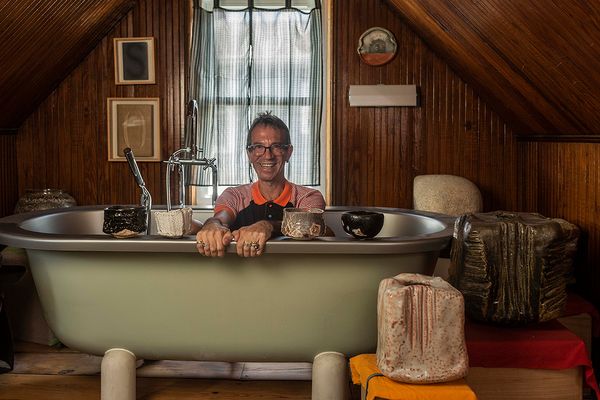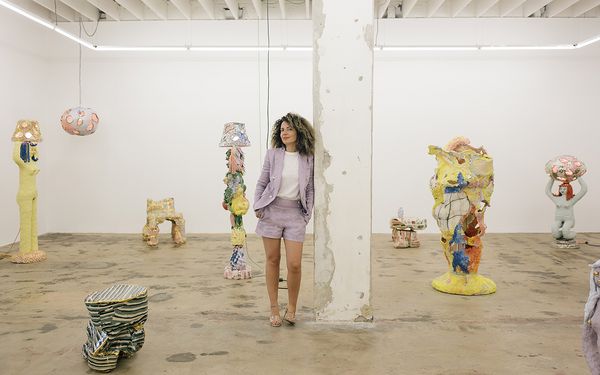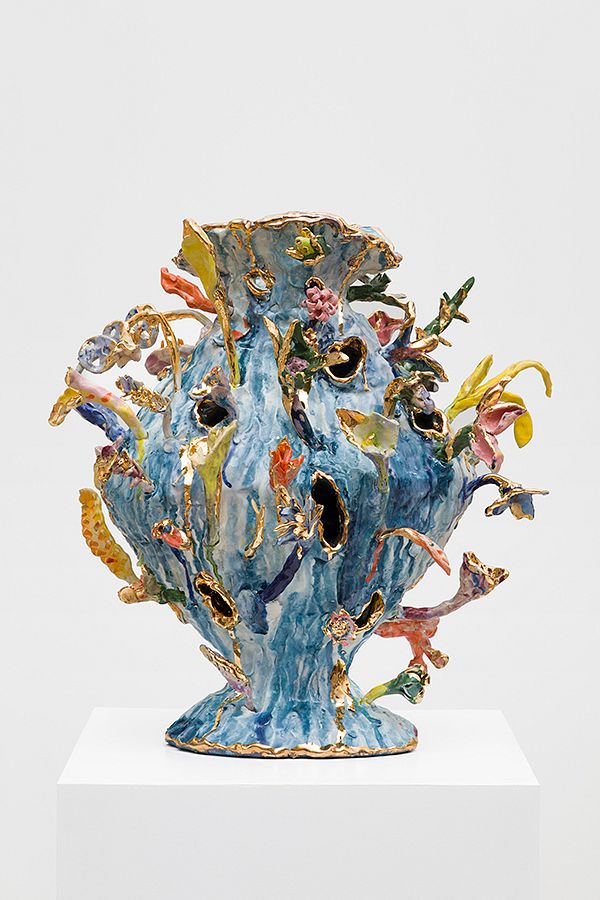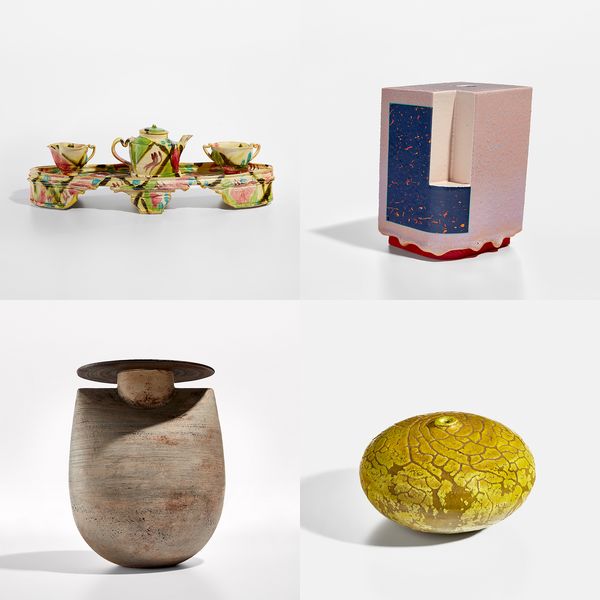Eva Hild in her studio. Photograph: Anna Sigge.
Phillips invited five individuals in the art world to share their perspectives and experiences with the medium. Below are excerpts from these conversations.
Steven Korff is a collector of modern and contemporary Japanese ceramics based in Brooklyn, New York.
Eva Hild is a ceramist who lives and works in southwest Sweden.
Nina Johnson is the founder of her eponymous gallery in Miami, Florida.
Matt Bangser is a Managing Partner at Blum in New York.
Abby Bangser is the Founder and Creative Director of Object & Thing.
A Summer Arrangement: Object & Thing at LongHouse (May–September 2023). LongHouse, East Hampton, New York. Photo by Adrian Gaut.
Works pictured: Wood fired ceramics by Frances Palmer arranged in the windowsill inspired by other displays at LongHouse.
Phillips: You each approach ceramics from slightly different perspectives, yet you share a love for the medium and its infinite possibilities. What initially drew you to ceramics?
Steven Korff: In 1980, I had an antique store in SoHo on Thompson Street called Yesterday's Tomorrow which sold all kinds of crafts from the midcentury era — from ceramics to glass and furniture. I was particularly drawn to Abstract Expressionist ceramics after reading a catalog that was produced in 1966 at the University Art Gallery in Irvine, California. From then on, I started selling and collecting artists such as Otto and Gertrude Natzler, Peter Voulkos, Ken Price, John Mason, Robert Arneson, and Ron Nagle, among others.
Eva Hild: The material is easy to find, it’s non-exclusive, and it gives the possibility to work in a wide range of object types — from functional ware to abstract sculpture. With my background in an academic setting, it was easier to start with a material-based art expression. From that point of view, I could explore and develop my artistry.
Nina Johnson: I had an amazing introduction to ceramics through Betty Woodman. Camilo Alvarez at Samson Projects in Boston was generous and gave me Betty’s contact information and suggested I reach out. That was my first time showing ceramics, but even then it wasn’t a choice to show ceramics. My reaction was more, “Wow I don’t know what this is and it’s incredible.” Not long after that that I discovered Katie Stout, through the suggestion of Alexandra Cunningham Cameron. Having the experience of showing and appreciating Betty’s work opened me up to the work of Katie Stout. So, it was just a serendipitous thing where one person led me to another. When we started showing Katie, she was an object maker — working with paper pulp, fabric, and other materials. It was attractive to me because it was exploratory. To me, working with clay was just another form of painting, and I saw no difference between one and the other.
Abby and Matt Bangser: Given that we both work with contemporary artists, we are always learning and expanding on the work that we know. The ceramics we live with are most often by artists who we share friendships with, or meet after collecting their work, and more recently we have been adding earlier 20th century works.
I remember seeing a Ken Price Geometric cup in the late 1970s which was way too expensive for me at the time, but the piece totally blew my mind. From that moment on I was completely hooked.
—Steven Korff
Steven Korff in his Brooklyn home surrounded by some of his Japanese ceramics.
Photo: Dave Sanders.
Phillips: What is it about ceramics that you find most interesting?
Eva Hild: The plasticity and unlimited use. The wide range of expressions. The direct interaction between material and hand, head and heart, intuition and control. The clay going from the soft, wet and plastic state through slow drying, into the fire and finally reaching a hard and eternal shard. It is really a transformation.
Nina Johnson: The tactility. I love that you can touch them. I’ve seen people touch paintings at art shows. And in some of Katie’s work, you literally have to touch the nipple to turn the light on. I also love this idea that it is literally dirt.
Nina Johnson in her gallery on the occasion of Katie Stout’s exhibition Sour Tasting Liquid (2020).
Photograph: Gesi Schilling.
Phillips: Is there something that ceramics uniquely offer, as opposed to other types of art or design? To you personally or professionally?
Nina Johnson: The material aspect of it is really important. There are people who need to put their hands on something. See their fingerprint. To literally mold something. For collectors, I think it’s the warmth and familiarity of ceramics which make it more approachable. Everyone has held a plate, owns a coffee mug, or has maybe purchased a vase at a flea market. Whereas with painting, there is an otherness or formality to it. Maybe you were told not to touch it, not to play nearby it. So, it’s probably an instinctual familiarity that allows people to approach it with less of a barrier than they do with other media. And that is really exciting to me.
Abby and Matt Bangser: We live in an era of such fast-paced consumption, that it is very restorative and nurturing to take time for the handmade.
Katie Stout, Blue Edith, 2023. 22 x 21 x 13 in. Image Courtesy the Artist and Nina Johnson. Photography by Greg Carideo.
Phillips: How do you live with ceramics and incorporate them into your life?
Steven Korff: I luckily live with and display my complete collection in a home where I have enough room to exhibit it. Some works are placed on their original signed and sealed boxes and others in places all over my house. I live in my own museum of Japanese contemporary ceramics which I can view, touch and use every day. Obviously, my family is not always happy with the amount of ceramic art we own but we work it out somehow.
Abby and Matt Bangser: We live in a Modernist house designed in 1964 by Hugh Smallen in New Canaan, Connecticut — an area not too far from New York City that was an important center for Modernist residential architecture in the 1950s and 1960s. The main living space has a long wall of glass windows looking onto moss and trees, so many of our ceramics are situated in this room in dialogue with nature. We have a large tsubo work from Kazunori Hamana and a Yuji Ueda work next to the fireplace, bringing the ceramics right back to the flame. We have lots of smaller scaled works placed with our books — a Doyle Lane weed pot, face jugs by Jim McDowell, a Ruth Duckworth sculpture, Arne Bang bowls and several works by Masaomi Yasunaga. We also use ceramic works at our dining table and often have vases by Frances Palmer filled with flowers, or serve food from micaceous vessels by Johnny Ortiz-Concha.
How does this exist? This object is so frail and delicate and it’s unbelievable that it is here in our world. And I think that’s something that is almost impossible to get over.
—Nina Johnson
Phillips: How has your ceramics collection or program, which features artists who work with clay, evolved?
Steven Korff: My ceramic collection has evolved over the years from mostly owning American and European pieces such as Ken Price and Hans Coper to no longer holding any American or European pieces but completely delving into the masters of contemporary Japanese ceramics, of which I now own over one thousand pieces. This started when I came in contact with the ceramics of Kamoda Shoji, which happened in the late 1980s. From then on, the Japanese aesthetic powered me on to my passion which has been with me for over thirty years.
Nina Johnson: Obviously, I know a lot more than I once did. I’m always cautious to say that I’m an art dealer and not an art historian. I’m driven by my own curiosity. When I learned about Beatrice Wood, maybe a more scholarly person might have known about her, and the same with Woodman, maybe I should have known but I didn’t. What I love about my business is that I’m allowed to be driven by my curiosity and that’s constantly teaching me new things and pushing my borders of understanding. Ceramics has been a big part of that.
We live in an era of such fast-paced consumption, that it is very restorative and nurturing to take time for the handmade.
—Abby and Matt Bangser
A selection of ceramics on offer in the December 5 Design auction.
Top left: Betty Woodman, Untitled, 1980s
Top Right: Ron Nagle, “Retro-Geo”, 1996
Bottom left: Hans Coper, "Sack and Disc" form, 1968
Bottom right: Doyle Lane, Weed pot, circa 1970
Phillips: Eva, are there any specific individuals who have been influential to the way that you engage with ceramics?
Eva Hild: I have looked more into the art world and been influenced by sculptors working in different materials, such as Lousie Bourgeois, Antony Gormley, Tony Cragg, Lynda Benglis, and Alice Aycock. I am more influenced by these powerful and engaged artists rather than a specific material.
Phillips: Abby, are there any specific individuals who have been influential to the way that you engage with ceramics?
Abby Bangser: I feel very lucky to have a close friendship with a ceramist we work with at Object & Thing, Frances Palmer, who lives near us in Connecticut. We share lots of afternoons in her studio talking about ceramics, her garden and life over tea — and usually something wonderfully delicious that she bakes. I often find that ceramists are also very talented cooks and bakers.
Clay is the prerequisite for creating and developing my work — it is my love, everyday friend, and follower.
—Eva Hild
Phillips: Do you feel collectors of ceramics share any particular traits?
Nina Johnson: They tend to be, in my experience, more concerned with process, history — what is the legacy, the historical predecessors? A lot of ceramic collectors are women, which could also be my perspective, and has to do with my gallery’s program. I have appreciated that ceramics have been brought into the mainstream fold of collecting, without that kind of segregation that existed before. It’s really wonderful to see ceramics approached as any other sculpture would be, but one that has this specific and rich tradition behind it. I also think it’s really validating and rewarding for the collectors, artists, and institutions that have appreciated this material for so long.
Abby Bangser: I do think there is a shared respect and admiration for natural materials, a handmade process and taking one's time to appreciate the special rituals in daily life.
Matt Bangser: The great collections of objects, with an emphasis on ceramics, seem to share a slow and methodical accumulation of the works over many years and travels. These types of collections always feel to me to be extremely personal, lived with, and considered.
Recommended Reading
Rembrandt, the Other Bugatti >





